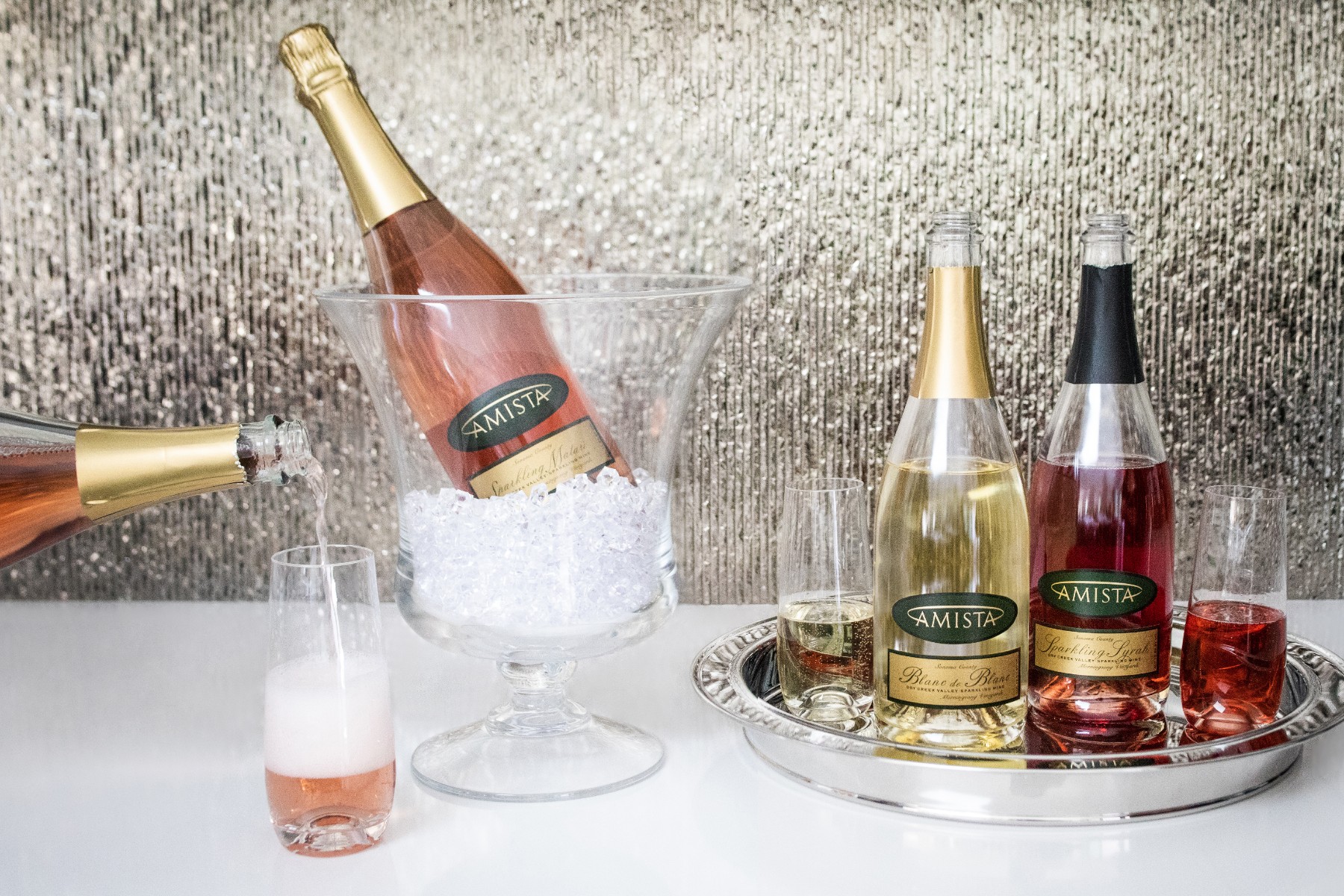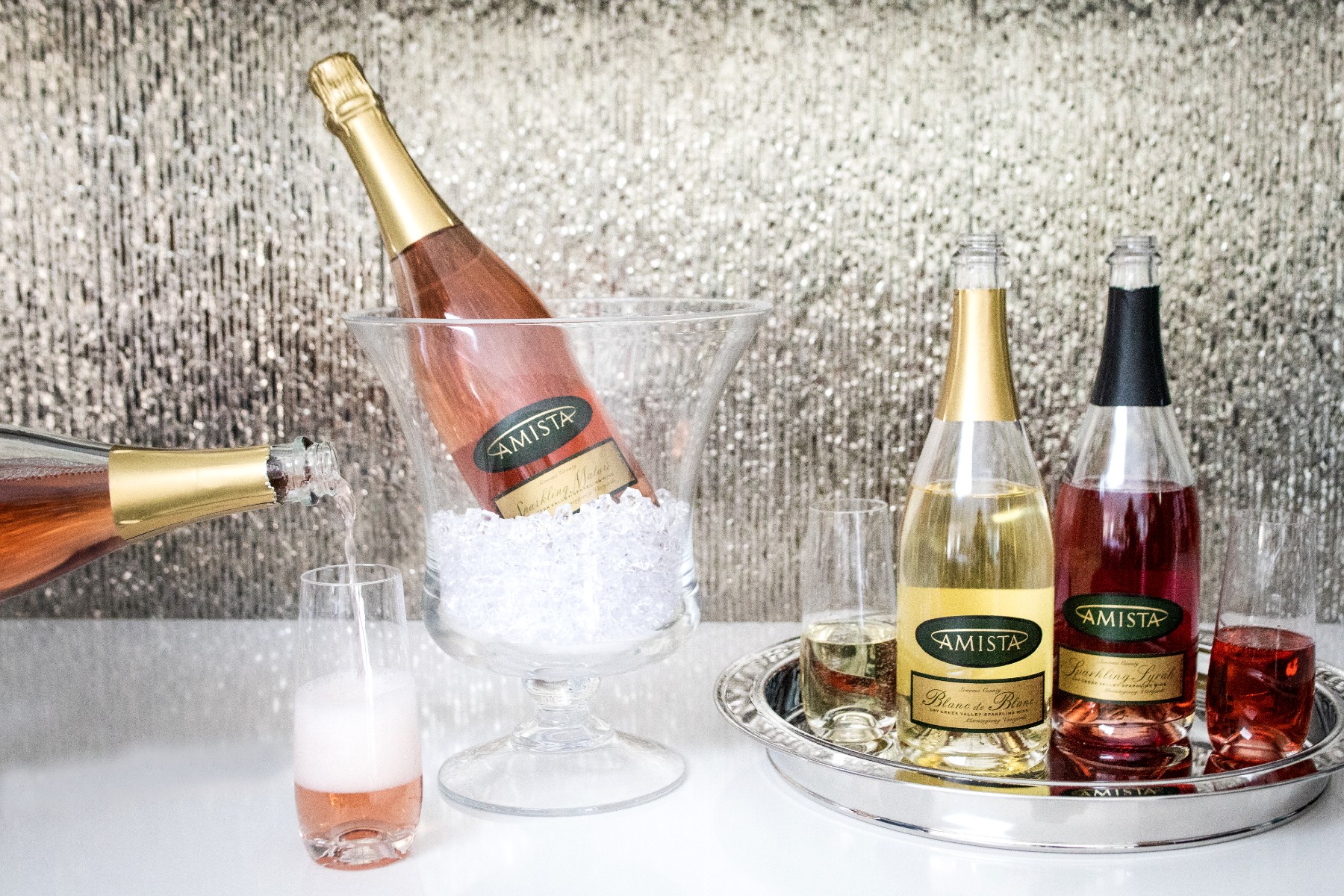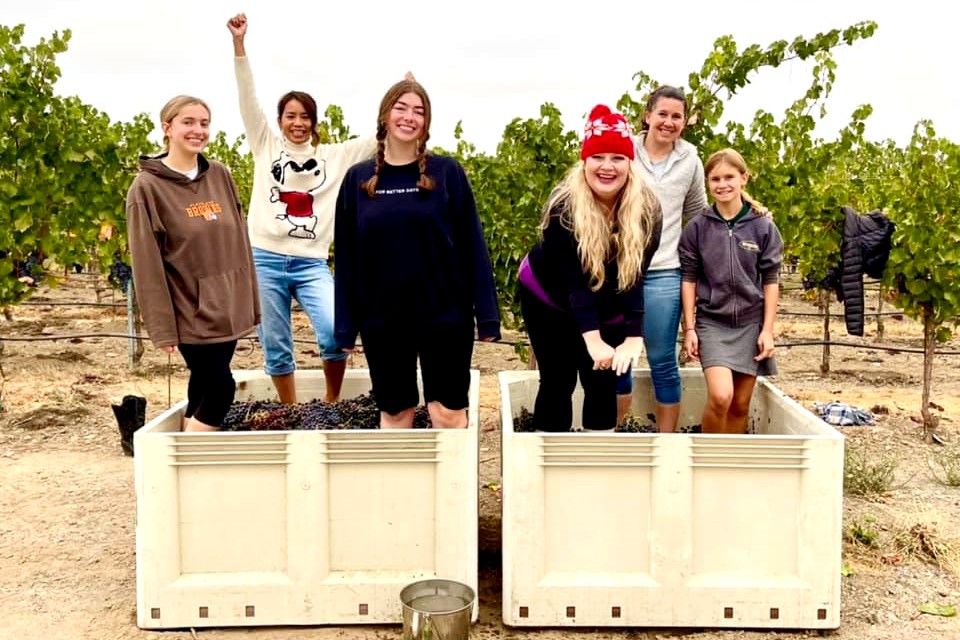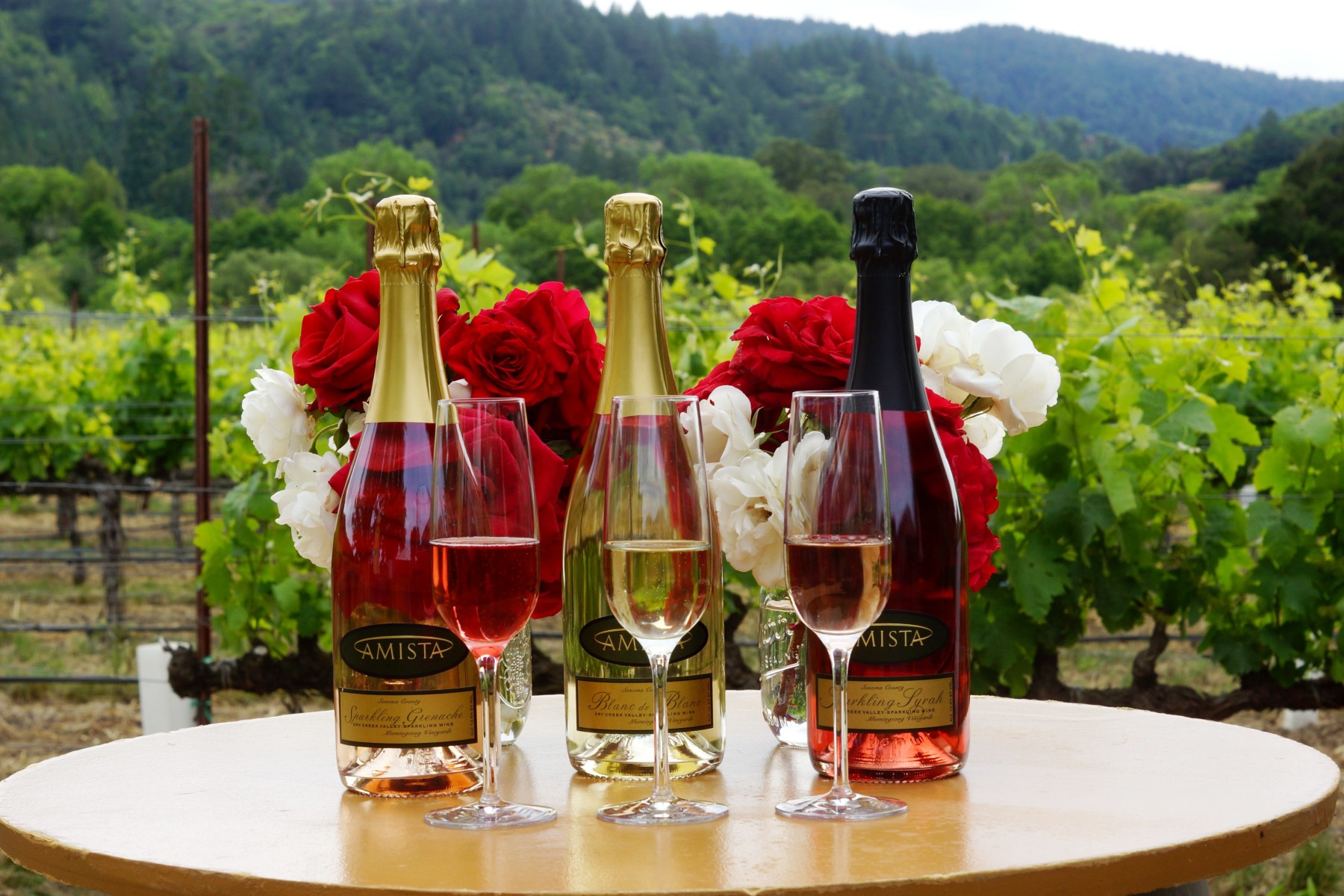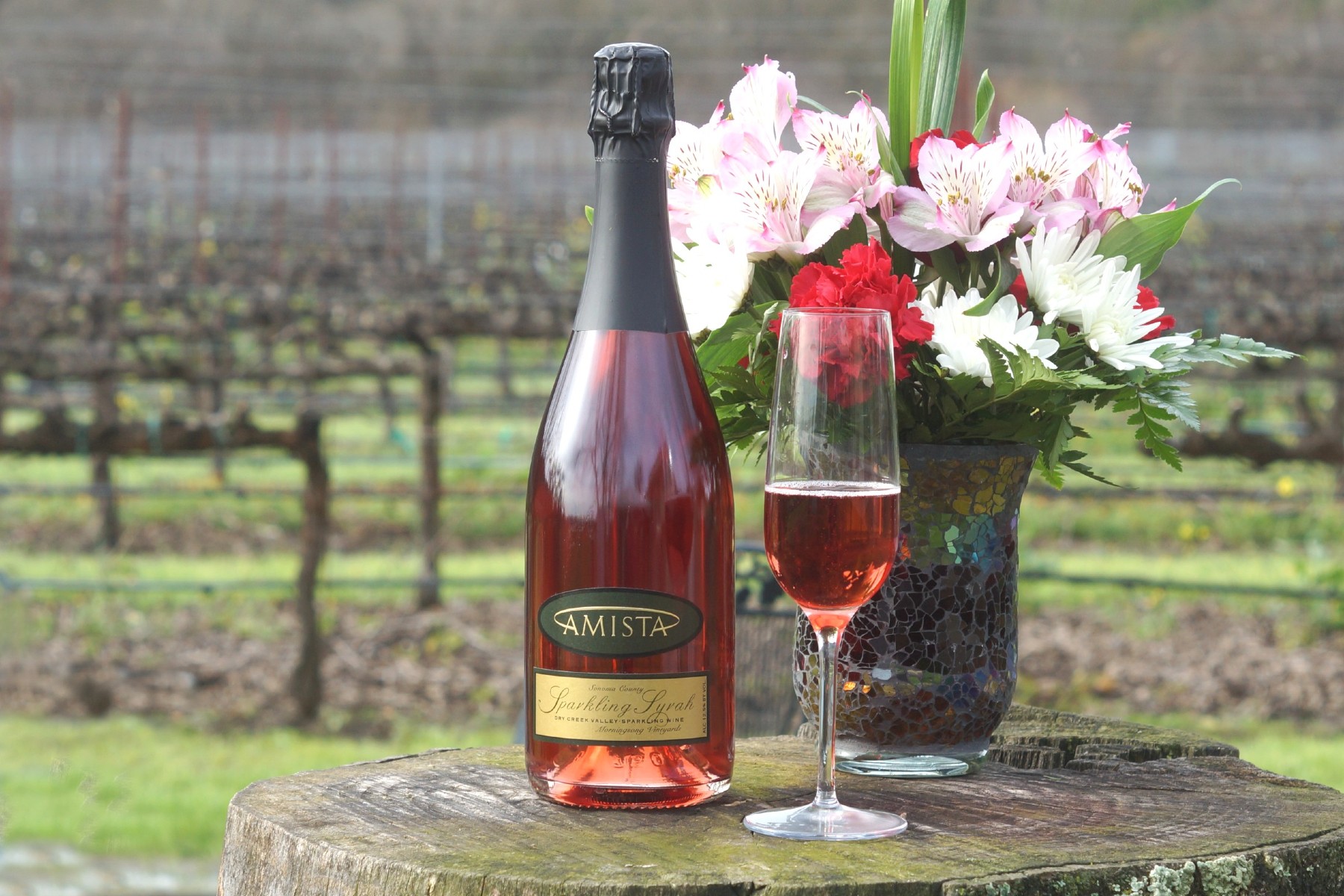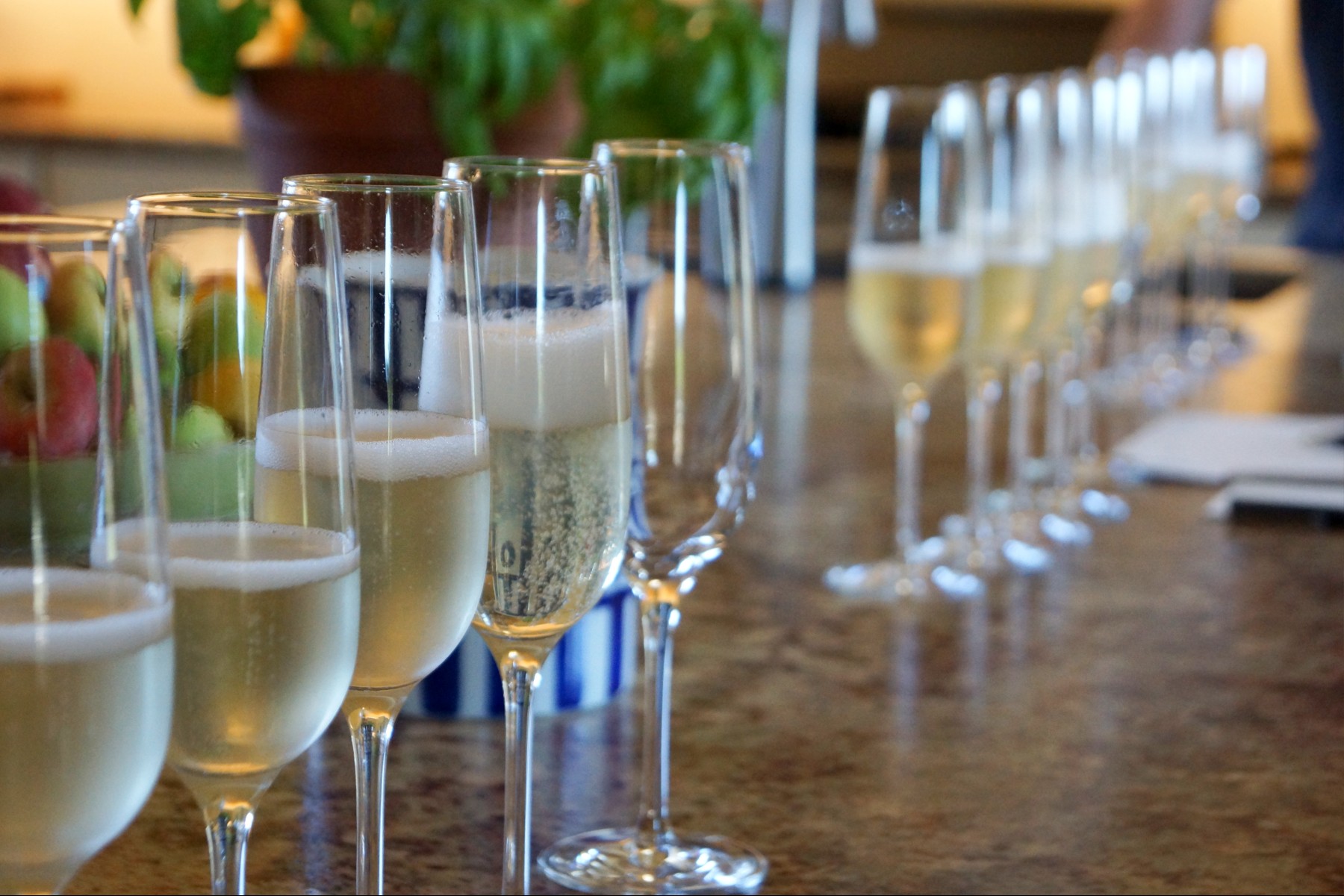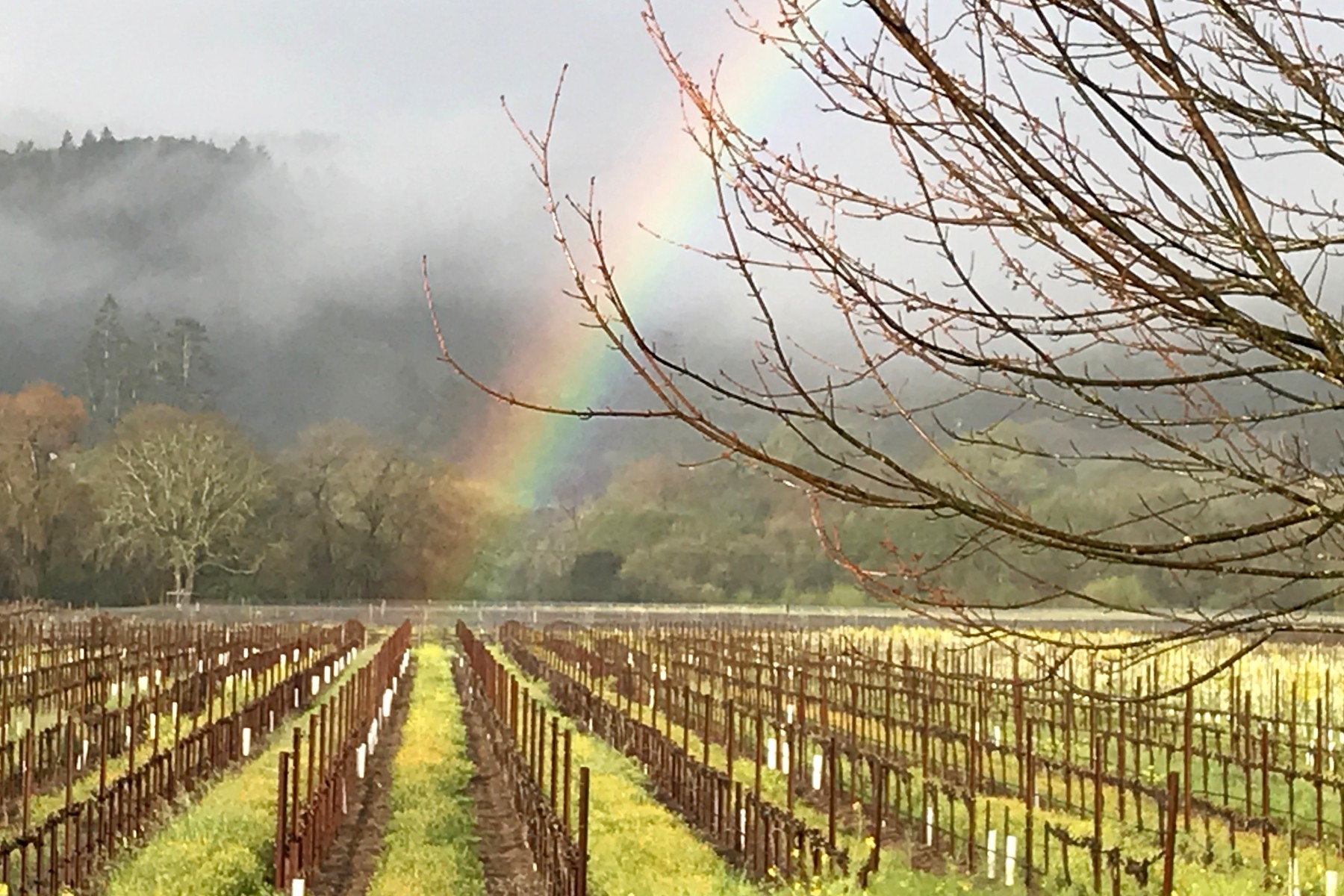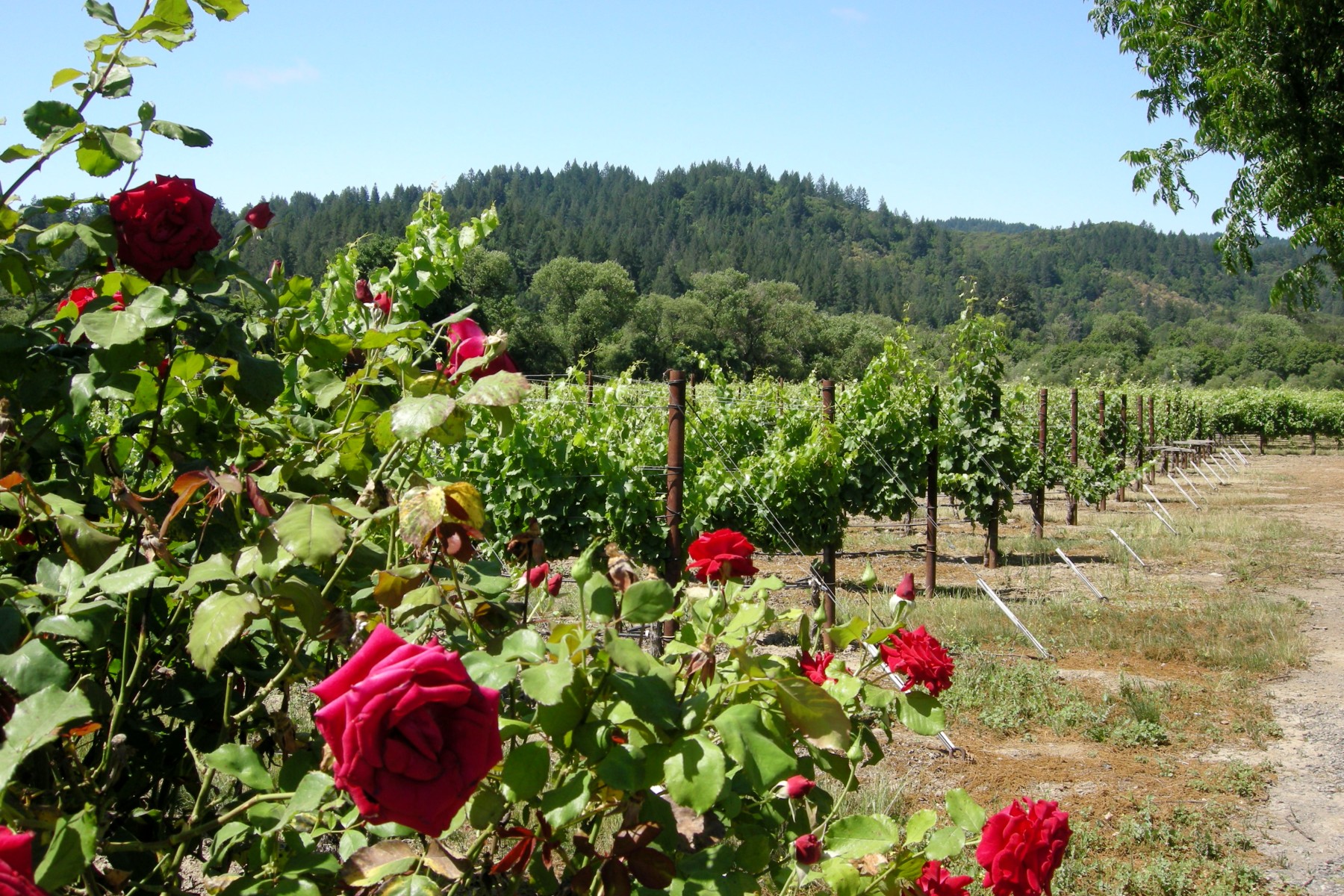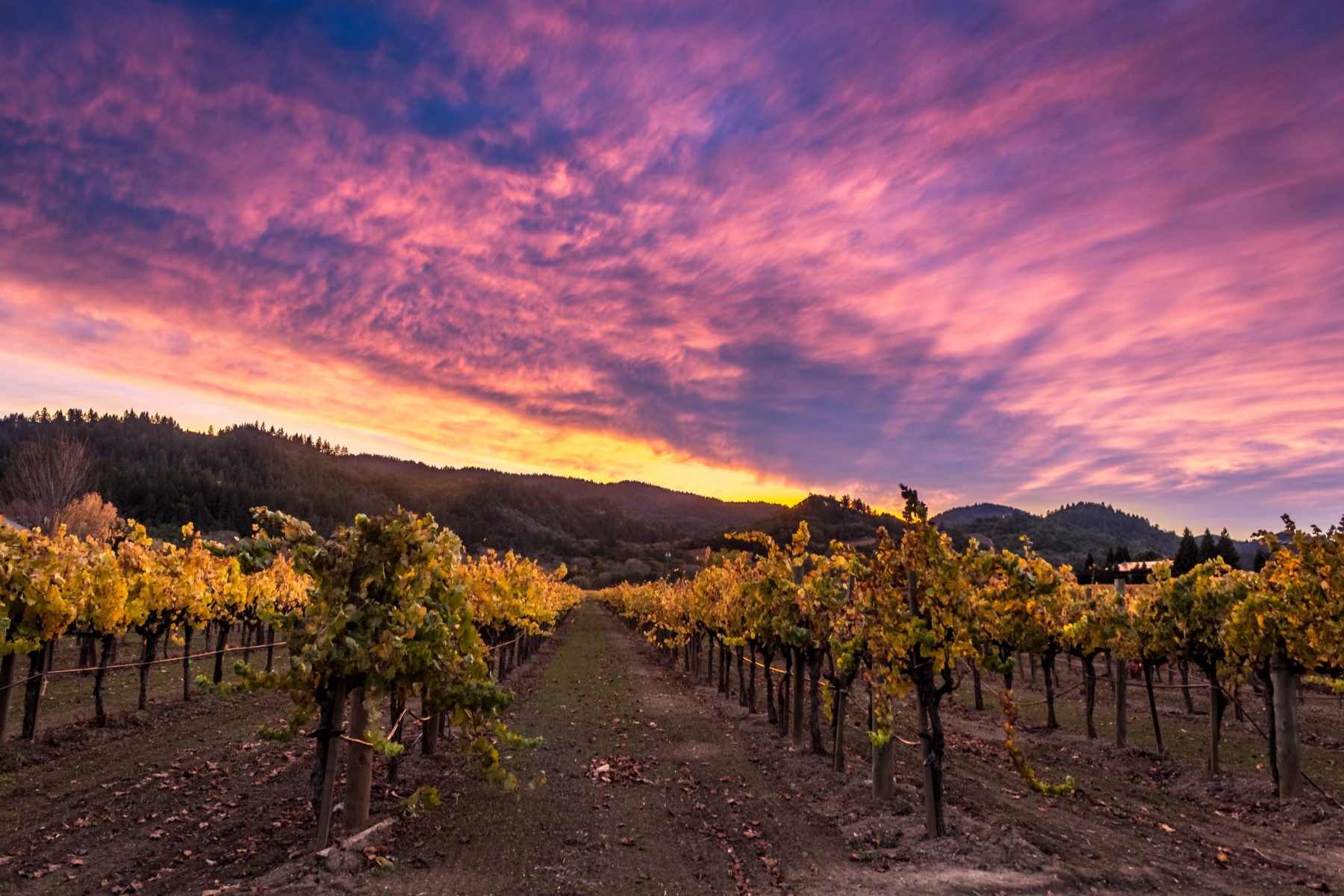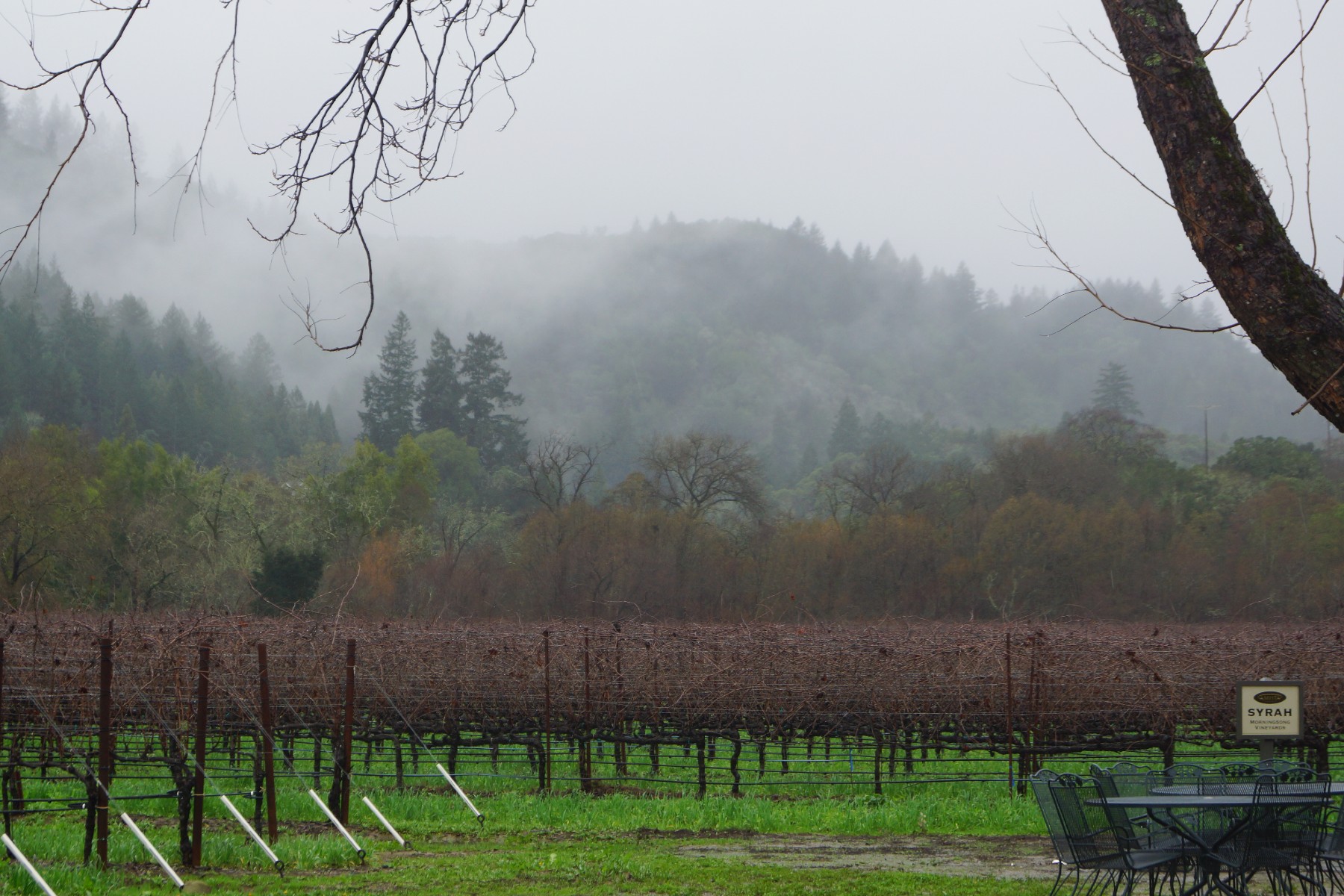News from Amista Vineyards
Becoming the First Sparkling Winery in Healdsburg, 5 Surprising Discoveries
It's Not a Destination, It's a Journey
...and it's been both exhilarating and challenging. Here's what I've discovered.

We never thought we’d be in the wine business let alone be the first sparkling winery in Healdsburg. The creation of Amista Vineyards was a dream that my husband Mike and I never knew we had and never knew we shared. It emerged slowly over time. When we started, we made Chardonnay and Syrah from our estate Morningsong Vineyards and Zinfandel and Cabernet from the vineyards of our neighbors in Dry Creek Valley, in Healdsburg, California.
Becoming the first sparkling winery in Healdsburg wasn’t part of our plan, although to be honest, in those days we didn’t really have a plan. It all started when we made our first sparkling wine in 2008. That was five years after our first harvest in 2003, when we picked for red wines - Syrah, Zinfandel and Cabernet Sauvignon.
We are now known as the sparkling wine house in Dry Creek Valley in Healdsburg, California with six sparkling wines, a sparkling wine club and a sparkling wine tasting flight. It’s been an exhilarating journey of opportunities, setbacks, surprises, and a lot of lessons learned. Here are my five surprising discoveries.
Be open to serendipity
Discovery #1. Embrace serendipity because accidents and unexpected happenings present opportunities.
Seize the opportunity
Discovery #2. Seizing opportunities has been an important part of our journey to becoming a sparkling winery. I will admit that Mike is better at this than me. I like to research and think things through before acting. But when I’ve allowed myself to take the leap, it’s always turned out to be a good thing.
Full speed ahead
Discovery #3. When you’re on a roll keep going. Building on your successes creates momentum and energy in your team. Externally, it creates a buzz and tells the world that you are committed to building something bigger than just a one-time offering.
Keep innovating
Discovery #4. Experiment - don’t be afraid to fail. Trying new things is sometimes the only way to know what will happen. Often, the experiments are great successes. Sometimes they fail. So, I like the to remind myself of the two sides of the same coin: “when you’re on a roll, keep going” and “when you’re in a rut, quit digging”.
Bend, don’t break
Discovery #5. Be flexible AND stay true to what is most important. This is a fine line to walk, and we haven’t always gotten it right. It’s helpful to remind ourselves of the things that are fundamental to our values and our brand and the things that can change over time as circumstance and experience evolve.
We are proud to be the first sparkling winery in Healdsburg, with estate grown fruit from our vineyards in Dry Creek Valley and honored to stand alongside the pioneering sparkling wine houses that came before us and paved the path for sparkling wineries in Sonoma County.

Still Thirsty?
Here are a few of the stories that illustrate the things I’ve discovered on the journey to becoming a sparkling wine house in Dry Creek Valley.
Be open to serendipity
I’m convinced we would not be Healdsburg’s first sparkling winery if it weren’t for a series of happy accidents.
Prevent a Spillover, Create a Rosé
In September 2005, we decided to try harvesting our Syrah by machine. Mike was in the vineyard at night (machine harvesting is typically done at night when it’s cool) supervising the pick. He was enthralled watching the machine go up and down the rows and got so excited that he kept asking the operator to pick more rows. He didn’t want to stop.
The next morning, he was still reveling over his midnight pick when he got a call from someone at the winery. They told him he had 10 tons of Syrah grapes in a 10-ton fermentation tank, and when the wine started fermenting, it was going to bubble over, go all over the floor and he was going to have to clean it up.
He swiftly moved into action and had 200 gallons moved from the tank to neutral barrels. Neutral barrels have been used in prior years and impart no oak to the wine. His idea was that once the Syrah in the tank was fermented and moved to barrels, he would combine it with the juice he had removed.
In early January of 2006, we went down to the winery with our winemaker, Chris Wills, to taste all the wine in barrels. We decided to taste the wine that had been removed to avoid the spillover. It had spent very little time on the skins, so it was a rosé rather than a red wine. We tasted it. It was fantastic. We decided on the spot to keep it separate from the other Syrah and bottle it as our first Rosé of Syrah. This was step number one in the serendipity that would lead to our first sparkling wine.
Sparkling Syrah from a Class Winemaking Project
Step number two didn’t occur until two years later. Our Rosé of Syrah had become a big hit and we continued to make it each year. In 2007, Chris (our winemaker who helped us decide to make our first rosé) asked if he could have some of the current vintage of our Rosé of Syrah to use to teach his class at the junior college how to make a sparkling wine using the classic Methode Champenoise. This is the method used to make fine French Champagne. We immediately said yes, on the condition that we got to try the finished product.
When we tasted it, we knew we had to make more for ourselves and our friends. We sent one barrel each of our 2007 and 2008 Rosé of Syrah, to a custom crush winery specializing in sparkling wines. This is where the second fermentation in the bottle was done, transforming a still wine into a sparkling wine. We released it in 2009 at our first Sparkling Holidays party. Mike celebrated the occasion with what has now become a tradition at this party of opening the bottle with a saber.
Discovery #1. Embrace serendipity because accidents and unexpected happenings present opportunities.
Seize the opportunity
Some opportunities present themselves in a flash and you must decide with no time for research or reflection. Others only occur to you if you are open to change. Some feel like they were just meant to be.
Our First Rosé – From Problem to Opportunity
Mike had just a few hours to figure out what to do with the excess Syrah in the 10-ton fermenter before it spilled over forcing him to don rubber boots (he didn’t have any) and wash the spillage down the drain with a big hose. Fixing that problem created an opportunity – a chance to make our first rosé.
OK Rosé – Trust Your Intuition
Sometimes opportunities are unseen because of a mindset of “this is how we do things”. We had never made a rosé in our early years in the wine business. It wasn’t something we even considered. We hadn’t done any customer research to see if anyone would like it much less buy it. Rosés are popular now in the U.S. but that wasn’t the case then. When we tasted it and loved it, we immediately decided we’d find a way to market it. I’ve learned that listening to intuition can be a path to innovation.
Sparkling Syrah – It Just Felt Right
On the other hand, seizing the opportunity was a piece of cake when we made the decision to make a sparkling wine from our Rosé of Syrah, at least for me. Although making a sparkling wine is far more complicated and expensive than making a still wine, I was undeterred.
It helped that our winemaker, Chris, had experience with sparkling wines and knew of a new winery specializing in making sparkling wines that had recently emerged on the local wine scene. Making it ourselves would have been impossible but partnering with a custom crush operation could make it viable. Besides, I love bubbles and thought it would be fun to make our Rosé of Syrah sparkle!
Discovery #2. Seizing opportunities has been an important part of our journey to becoming a sparkling winery. I will admit that Mike is better at this than me. I like to research and think things through before acting. But when I’ve allowed myself to take the leap, it’s always turned out to be a good thing.
Full speed ahead
We had three years of making Sparkling Syrah under our belt and I was ready to move full speed ahead with another sparkling wine.
Next Stop – Sparkling Blanc de Blanc
Ashley Herzberg joined as our new winemaker in 2011 and I asked her if she thought we could make a Blanc de Blanc from our chardonnay grapes. She had never made a sparkling wine, but she too loves bubbles and said, “Absolutely”.
A few months later we harvested some of our Chardonnay to make our first Blanc de Blanc. The inaugural release of our Amista Blanc de Blanc in 2013 scored 91 points and won a gold medal in the Press Democrat’s “Best of the Best” North Coast Wine Challenge. I absolutely fell in love with this wine, and it continues to be my go-to bubbly. There’s nothing like personal satisfaction and public recognition to encourage full speed ahead, so we kept going!
On a Roll – More Sparkling Wines and Healdsburg’s First Sparkling Wine Club
In 2013 we started making not one, not two, but three sparkling wines to add to our portfolio, a Sparkling Grenache, a vintage Blanc de Blanc (technically a late disgorged version of our Blanc de Blanc) and our first sparkling blend called Fusión.
In 2014 we launched Healdsburg’s first sparkling wine club at the annual Passport, Dry Creek Valley's premiere food and wine event. Then in 2016 our Sparkling Mataró made its debut and in February 2022, we will release our second sparkling blend called Sparkling Tres, another rosé, made from Grenache, Syrah and Mourvèdre.
Discovery #3. When you’re on a roll keep going. Building on your successes creates momentum and energy in your team. Externally, it creates a buzz and tells the world that you are committed to building something bigger than just a one-time offering.
Keep innovating
Sparkling Wines from Non-Traditional Grapes
Our first sparkling wine was made with a grape that is never used in classic French Champagne, Syrah. Tradionally, Champagne and sparkling wines are made from Chardonnay and Pinot Noir grapes. The Australians make a bubbly called Sparkling Shiraz from the Syrah grape, but it is a very deep red color and slightly sweet. Our Sparkling Syrah is a rosé, glittering cranberry in color and quite dry.
Most of the grapes we grow on our own vineyards are Rhône varieties – Grenache, Syrah and Mourvèdre. Using those grapes rather than the classic Champagne varieties, is one of the ways we innovate. The other non-traditional approach we take is to produce sparkling wines from single vintages. Although we don’t vintage date them, each bottling comes from a single year (except that first Sparkling Syrah). Most Champagnes and sparkling wines are blends from several vintages. We have the luxury of beautiful California weather, so we don’t need to save the “good years” to blend with the bad.
Glittering Sparkling Wines in Non-traditional Bottles
In addition to using non-traditional varieties, we also use non-traditional bottles. Most sparkling wine is bottled in dark green glass. This makes sense because the dark glass protects the delicate wine from the bright lights in the wine shops. Since we don’t sell our wine in shops – only from our website, tasting room and wine club – we get the privilege of using clear glass bottles.
This just plain makes me happy because lining up our sparkling wines creates a glittering array of precious gems. I love seeing the color of the wine in the bottle – from the gorgeous gold of our Blanc to the blush-colored Fusión all the way to the deep cranberry color of the sparkling Syrah. I’m not sure anyone else cares, but there should be some things about owning a winery that make the owner smile, right?
Healdsburg’s First Sparkling Wine Club, with a Twist
Another innovation was the introduction of the first sparkling wine club in Healdsburg. We were eager to launch it in April of 2014 at Passport, the premiere food and wine event in Dry Creek Valley, but we only had two sparkling wines at that time. We knew we had others coming, but we didn’t want to miss the opportunity to introduce our club to so many people. We decided to borrow from the idea of selling wine futures. People could sign up for our sparkling wine club in April and purchase their first shipment which would arrive later in the year. It worked!
Dosage Trial Tastings – a Big Flop
A big part of being innovating is taking risks and not being afraid to fail. We had what we thought was a brilliant idea to offer “Dosage Trial Tastings”. The tasting would be led by Ashley, our winemaker, and guests would experience the process of deciding on the dosage (the dose of sugar syrup) to be added to the wine to achieve the perfect balance and mouthfeel. The dosage level also determines whether a sparkling wine is designated as Brut, Extra Brut or Brut Nature (dryer) or Sec, Demi-sec and Doux (sweeter).
Dosage trials are one of my most favorite parts of having a sparkling wine house. In fact, all of us love doing them but apparently no one else did. Another local sparkling house started offering them right after we did. I guess it seemed like a good idea to the producers, but the dogs weren’t eating the dog food. We dropped them. Now we offer a sparkling flight of our bubbles which is wildly popular.
Late Disgorged Blanc de Blanc – Complicated and Expensive
Another thing we tried was making a late disgorged Blanc de Blanc. For many reasons, it turned out to be more complicated and expensive to produce than we expected and there were several production mishaps. We dropped the wine from our lineup after a couple of vintages, but this is one we’re going to revisit. Stay tuned!
Discovery #4. Experiment - don’t be afraid to fail. Trying new things is sometimes the only way to know what will happen. Often, the experiments are great successes. Sometimes they fail. So, I like the to remind myself of the two sides of the same coin: “when you’re on a roll, keep going” and “when you’re in a rut, quit digging”.
Bend, don’t break
I’ve talked a lot about being flexible, open, and resourceful and those have been crucial parts of our journey. At the same time, it’s important to stay true to your values and your brand. For us, the quality of the wine and the quality of the partnerships with our guests and our team are fundamental.
Committed to the Traditional Methode Champenoise
We use non-traditional glass and non-traditional grapes, but all our sparkling wines are made using the traditional method for making fine French Champagne and sparkling wines. The grapes are picked at a lower brix level (sugar content) and the wine goes through a second fermentation in its own bottle. There are other less expensive and time-consuming ways to produce bubbles, but we remain committed to the traditional process because it delivers the highest quality sparkling wine.
Partnering with our Employees During the COVID Shutdown
One of the things we value is partnership, with our customers and with our team. When our tasting room was shut down due to COVID, it was another of those anxious moments – a huge challenge with no clear path forward. We decided to keep all our full-time employees on board and offer as many hours to our part-time team members as we could. Instead of working in the tasting room, they got on the phones from home and called our customers about their wine club orders.
We sent each team member a care package of wine and did a virtual tasting - one wine each week. The wine tasting was fun, but more important was the fact that we were staying connected and supporting each other through unchartered territory. And we connected with our members in the same way – virtually – enjoying not only wine tasting together but support and camaraderie.
A Sparkling Wine House Must Have a Sparkling Flight
Once it became clear that we were a sparkling wine house and not just a winery that makes a sparkling wine, we realized we had to offer a bubbles flight to our guests. We offer a beautiful flight of reds and whites, but how can you be a legitimate sparkling winery without also offering a sparkling flight?
This was one of my pet peeves about sparkling houses before we became one. Most sparkling wineries also make Chardonnays and Pinots since those are the two common varieties in sparkling wine. Being a lover of bubbles, when I came to visit, I wanted to taste sparkling wines, but all the flights were a mix of sparkling, Chardonnay and Pinot.
Now I understand it’s easier said than done. Although we produce several different sparkling wines, some of them are very limited production and they sell out a few months after release. You can’t have a sparkling flight with just one wine on the menu, so we have had to work hard juggling releases and wine club allocations so we can offer a flight of sparkling.
Discovery #5. Be flexible AND stay true to what is most important. This is a fine line to walk, and we haven’t always gotten it right. It’s helpful to remind ourselves of the things that are fundamental to our values and our brand and the things that can change over time as circumstance and experience evolve.
We are proud to be the first sparkling winery in Healdsburg, with estate grown fruit from our vineyards in Dry Creek Valley and honored to stand alongside the pioneering sparkling houses that came before us and paved the path for sparkling wineries in Sonoma County.
11 Ways to Celebrate the Holidays with Sparkling Wine
Let us help you impress your friends
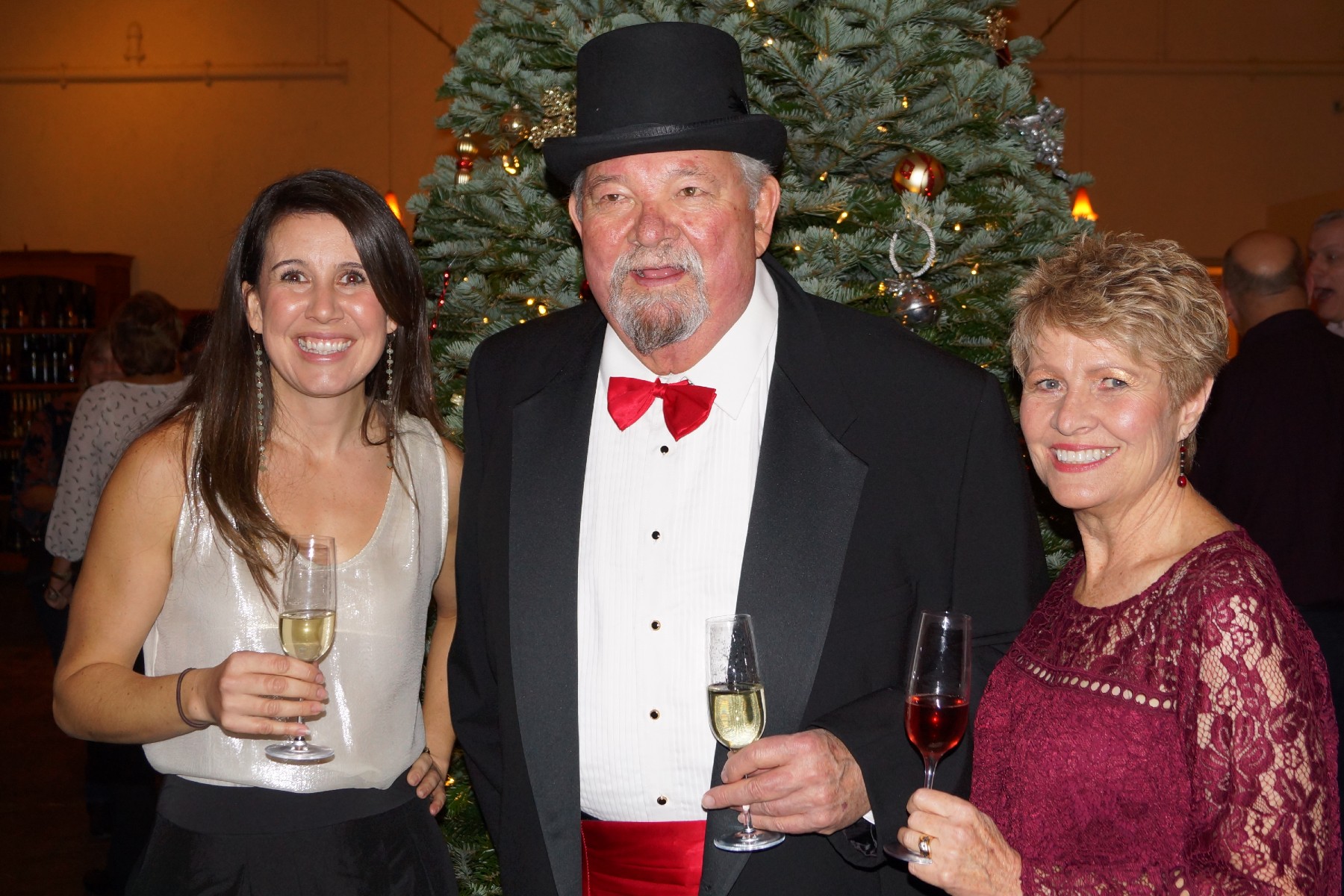
with spectacular sparkling wine and food pairings!

Ashley Herzberg (Amista Winemaker), my husband Mike and I love our Sparkling Holidays Soiree and look forward to it every year. The holiday season is a time for gathering with family and friends, enjoying special treats, and proposing toasts to health, happiness, and friendship. Sparkling wine goes with an extensive array of dishes and occasions, but it’s a must for the holidays. For the past eleven years, we have hosted a sparkling holiday party with superb local chefs who have created some incredible sparkling wine and food pairings.
These pairings wowed our guests, and they are sure to wow yours. I am excited to share my eleven favorite pairings of Amista sparkling wines with delectable dishes. But first I want to tell you how our sparkling soiree came to be. Or you can go directly to the pairings.
We hosted our first holiday party in 2007, having just opened our tasting room that August. We were excited to finally have a place to have a party. We decided on an afternoon open house and did the same thing the following year.
When we were ready to release our first sparkling wine, we decided it would make its debut at our holiday party. But an open house just didn’t seem to have the right sparkle. No more mundane open houses for us. We wanted something special for our club members and their guests. We introduced Amista Sparkling Holidays in 2009, an early evening soiree with live music, passed hors d'oeuvres and a massive tree with glittering lights in the middle of a festively decorated tasting room. It’s the one time a year we trade in our jeans and vests and get all dressed up. Mike can often be seen in his tux!
Mike performed his first sabrage at that inaugural event, opening the bottle of bubbles with a saber. It only took six tries! How do you perform a sabrage, you ask? After carefully removing the foil and wire cage from the bottle, you hold the bottle in one hand by its end and the saber in the other.
The trick is to find the seam in the bottle and quickly run the saber along the seam from the end of the bottle to the neck. If successful, the lip of the glass and the cork come out with a pop! Be sure to point the bottle away from everyone because the glass lip and cork come out at lightening speed. The glass cuts cleanly making it possible to safely pour the wine and our guests always line up to get the first taste of those festive bubbles.
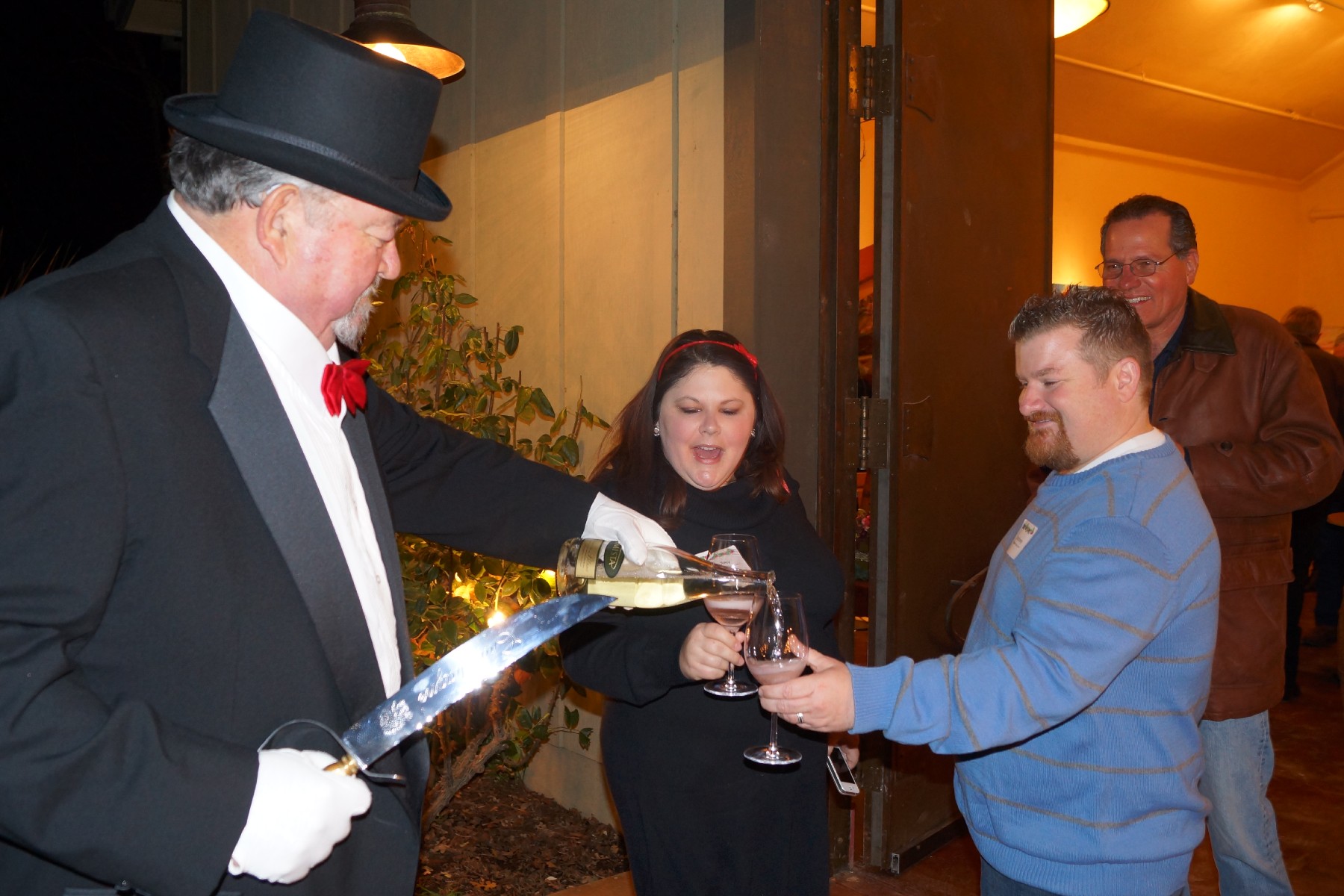
Our sparkling soiree and the sabrage ceremony have become traditions over the last 11 years.The tradition has become so important that we even found a way to have the party during COVID. We moved the tree outside under our new solar covered patio and set up small bistro tables, six feet apart for our guests.
It was a very chilly evening and the heaters we ordered had not yet arrived because it seemed everyone was buying heaters at the time. Our club members were undaunted and dressed up for the affair complete with face masks and multiple layers of clothing plus scarves, gloves, and hats. Everyone was thrilled to be out after spending so many months cloistered at home and the mood was celebratory.
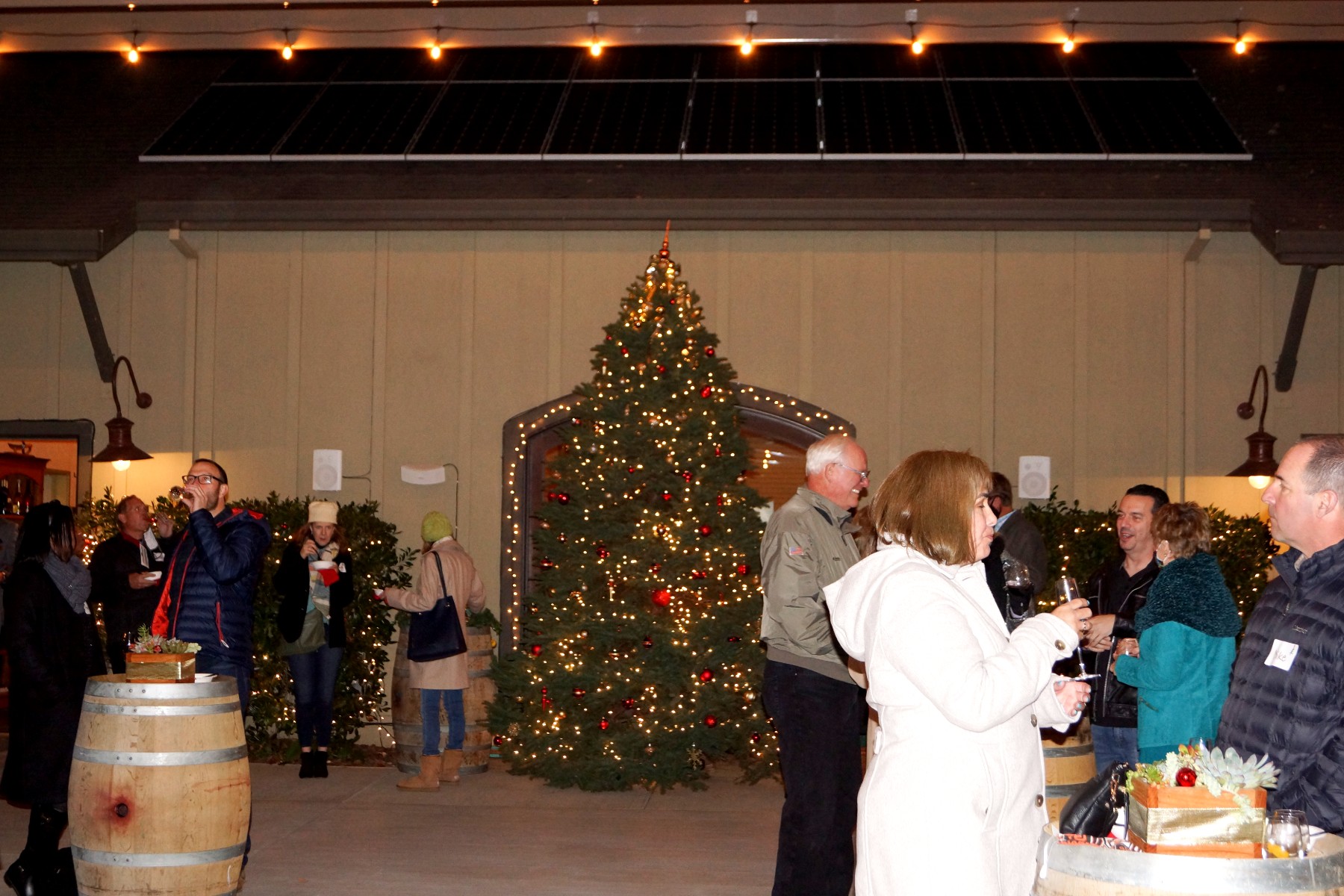
That night we introduced another tradition, a sparkling cocktail! Our friend Tara Jasper, founder, and chief distiller at Sipsong Spirits, created a signature cocktail just for the occasion. Freshly squeezed orange juice, Tara’s hand-crafted Indira gin, Amista Sparkling Syrah and a garnish of fresh thyme and cranberries served as the welcome for a truly, madly sparkling evening!
One year I decided it was time for me to try the sabrage. I was nervous. Maybe that was the problem. I’m not sure exactly what happened but instead of the glass lip and cork flying out, the whole bottle kind of exploded. I was surprised but relieved that everyone was safe…except me. I eventually noticed a chunk of glass in my index finger. Fortunately for me, we had three club members who are surgeons attending the event that night. They escorted me into the back, removed the glass, washed, and bandaged the wound and declared me ready to party on! It was a good reminder to be extremely careful when performing a sabrage. I know they say you should get right back on the horse that threw you, but honestly, I haven’t tried a sabrage since. So, I stick with my bubbles and bites. Here are my eleven favorites.
11 KILLER PAIRINGS WITH AMISTA SPARKLING WINES
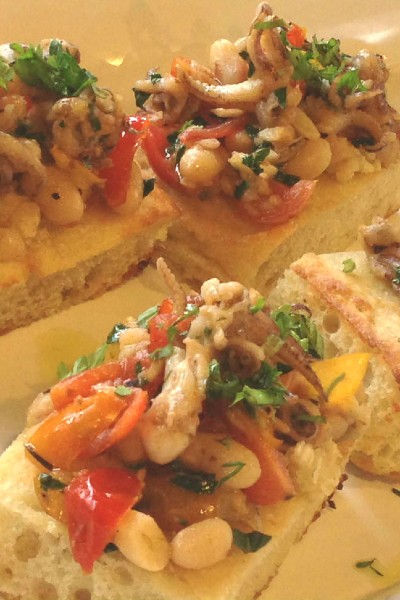
Blanc de Blanc with Tuscan calamari crostini
Sparkling Syrah with caramelized onions, blue cheese, and fig pizzettas
Sparkling Syrah with mushrooms stuffed with Italian fennel sausage
Sparkling Syrah with French cheesecake and raspberry coulis
Blanc de Blanc with lemon chive risotto cakes
Sparkling Syrah with seared ahi on a crisp wonton drizzled with wasabi aioli
Blanc de Blanc with Dungeness crab, marinated artichoke, and gruyere tart
Sparkling Grenache with lobster and brie mini puff pastry cups
Sparkling Syrah with cranberry-brie bites in mini pastry shells
Sparkling Mataró with mini brioche, Laura Chenel goat cheese, roasted pear, and pomegranate glaze
Sparkling Fusión with yellowtail sashimi, avocado, pickled red onions, pomegranate, and quinoa
We are looking forward to our 12th sparkling soiree this Saturday. I can’t wait to see our friends, try new pairings, taste the latest cocktail Tara is creating for us and watch someone (else) as they perform the traditional sabrage ceremony.
Cheers to a joyous holiday season filled with good food, good (sparkling) wine and good friends.
3 Surprising Reasons Sparkling Syrah and Thanksgiving are the Perfect Pairing!
Add good friends and you have the secret for good times
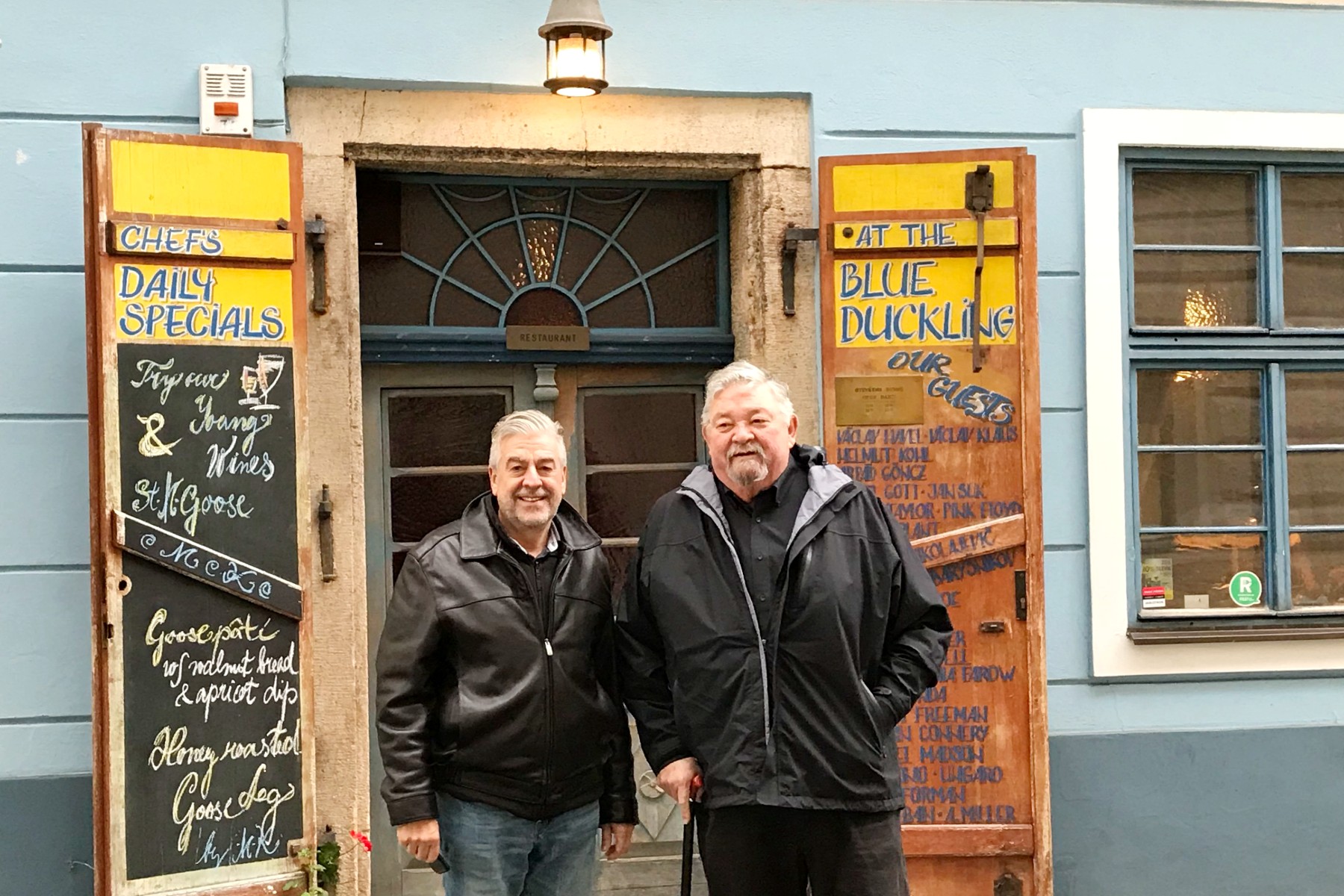
Let’s drink a Thanksgiving toast to friendship!

Yes, our Sparkling Syrah, which is a Rosé, will surprise you with how beautifully it goes with Thanksgiving dinner! But more about that in a minute. First, I want to talk a little about giving thanks. Thanksgiving is just around the corner and one of the things I am most thankful for as a wine business owner is the many friends who have shared our wine journey.
Amista means making friends (literally “it makes friends” in Spanish) and we chose it because our friends have always been our best cheerleaders, supporters, and sounding boards. It’s also because we believe that wine is better with friends!
Today I am reminiscing about an unforgettable time we had in Prague four years ago this month with dear friends Traudl, Bertram and their daughter Anina from Germany. My husband, Mike, met Bertram during his time at IBM when Bertram came to work on a post-graduate studies program. We quickly became friends with Bertram and Traudl when we were living in the Silicon Valley, gathering for dinner and, of course, wine.
Traudl and I have always been big fans of bubbles long before we knew we would start a winery and make our own sparkling wines in our new home in Sonoma County. Our friendship has endured over time and distance, even after they moved back to Munich and had a daughter – who was born (three weeks early) while Bertram was visiting us in California.
Our rendezvous in Prague came about because Amista was one of the winery hosts for a wine cruise on the Danube in November of 2017 and we planned to spend a few days in Prague following the cruise. It was an amazing cruise – but more about that in another post! It was the perfect reason to arrange to meet our long-time friends in Prague. The three of them all happened to be in different cities – Brussels, Munich, and Cologne – so it was a happy gathering for all of us.
Bertram was excited to introduce us to U Modré Kachničky, an intimate restaurant in Prague’s old town, that he had discovered on one of his business trips to the city. We went for a late and very long lunch in a cozy room we had all to ourselves. Good thing because there were many animated stories and raucous laughter as we caught up on each other’s lives! The afternoon was extraordinary, first and foremost because we realized once again that despite not being together for several years, it felt like only yesterday.
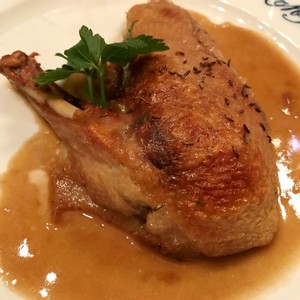 As has always been our custom, Traudl and I started with a glass of Champagne and Bertram and Mike started with a beer – this time a Czech beer. The food and service were spectacular. The restaurant is famous for its roast duck (the name of the restaurant means “at the blue duckling”), and it was hands down the best I’ve ever eaten. Bertram chose a lovely Czech red wine to go with our meal and all the ingredients for a remarkable afternoon came together.
As has always been our custom, Traudl and I started with a glass of Champagne and Bertram and Mike started with a beer – this time a Czech beer. The food and service were spectacular. The restaurant is famous for its roast duck (the name of the restaurant means “at the blue duckling”), and it was hands down the best I’ve ever eaten. Bertram chose a lovely Czech red wine to go with our meal and all the ingredients for a remarkable afternoon came together.
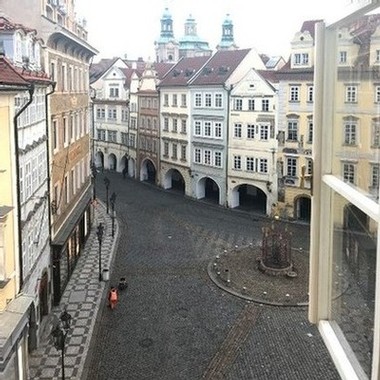
The previous evening Bertram, Traudl and Anina came for “cocktails” to our charming old-world apartment overlooking a picturesque plaza that we booked for our stay in Prague. We were excited to surprise them with a toast to friendship with our own Amista Vineyards Sparkling Blanc de Blanc that we had squirreled away after our winemaker dinner on the cruise.
We have gathered in many places over the decades. One year they all came to New Jersey to celebrate the millennium. Another time, Traudl and Anina came to Healdsburg to help us ring in the new year. That occasion also involved duck. Traudl made her famous Duck Breast with Balsamic Raspberry Sauce and the most decadent potatoes au gratin I’ve ever tasted. We introduced her to our Amista Sparkling Rosé of Syrah, which was a beautiful counterpoint to the rich duck and potato gratin.
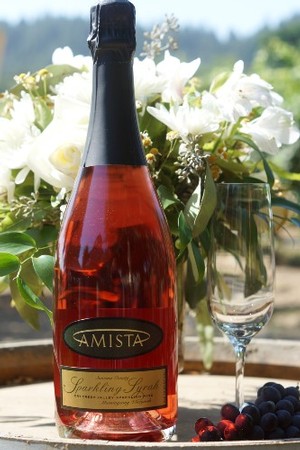 Sparkling Syrah is also our favorite wine to pair with Thanksgiving dinner and here are my top 3 reasons why:
Sparkling Syrah is also our favorite wine to pair with Thanksgiving dinner and here are my top 3 reasons why:
1. It has the tannins to stand up to hearty dishes
2. Its effervescence and bright flavors cleanse the palate
3. It brings a splash of joyous color to the Thanksgiving table
There are many sparkling moments to mark our friendship over the years, but probably the most heartwarming and wonderful was the day Mike and I flew to Munich to surprise Traudl for her 40th birthday. We made secret arrangements with Bertram to be in Munich for the special occasion and had the neighbors let us into their home just before Traudl arrived back from work. When she came up the stairs and into the living room and saw me sitting there, she screamed with joy – at least I hope it was joy and not terror! Of course, we marked the moment with a bottle of Champagne!
I hope you’ll drink a toast to good friends, good wine, and good times, along with me, this Thanksgiving.
What’s the Difference Between Champagne and Sparkling Wine?
Only the region where it’s made!
That’s why we call our Amista bubbles “sparkling wines” and not Champagne.

If your bubbles are not made in the Champagne region of France, you cannot call them Champagne. It’s a regulatory distinction, not a difference in grapes or the method used to produce the wine.
The method used in Champagne is called Methode Champenoise or Méthode Traditionnelle. We use the same method at Amista and that’s what makes sparkling wines extra special! Still wines go through fermentation only once and are then aged in tanks or barrels. Sparkling wines go through an extra fermentation - producing the delicate bubbles - and are aged in their own bottle.
Although we use the traditional method for crafting our Amista sparkling wines, winemaker Ashley Herzberg and I love to use non-traditional grapes. The classic grapes used in Champagne are Chardonnay, Pinot Noir and Pinot Meunier. Since we specialize in red Rhône varieties, we make Rhône sparkling wines. Each one has turned out to be a pleasant and delicious surprise.
Note: Today is International Champagne Day so let’s raise a glass to friendship. You can read more about "The Difference Between Champagne and Sparkling Wines" in Food and Wine.
Why A Blog?
As a woman winery owner, I have been asked lots of questions about what it’s like to be in the wine business and live the wine country life after spending decades in the corporate world. Here are my stories about the wonderful world of sparkling wines – which I love – and owning a vineyard in Dry Creek Valley. I am grateful I get to live near the charming town of Healdsburg, California, in the heart of Sonoma Wine Country. As with any endeavor, there are glorious moments and difficult moments. For me, each of them brings new discoveries and learning, which is why I call them “sparkling moments”.
About Me
I started with an education in psychology - pretty much useless for getting a job - which led me to explore breakthrough leadership and a career as an executive in several global corporations. Following my corporate career, I became an executive coach helping CEOs and their teams build the leadership skills they need to achieve top performance.
Getting into the wine business wasn’t exactly a plan. As I look back, I believe it was a dream that my husband Mike and I didn’t know we had and didn’t know we shared. When we started out together, we never knew we'd end up living in Sonoma's beautiful Dry Creek Valley surrounded by our own vineyards. From planting our first vineyard in Silicon Valley, to tasting our first “garage-made” wine out of the barrel with friends in our basement in New Jersey, to eventually moving to this beautiful property in the Dry Creek Valley, the creation of our winery, Amista Vineyards, unfolded over many years and in several locations.
Owning a winery has catapulted me into a leadership role that is both challenging and exhilarating. I love crafting our business strategy, meeting our guests, and nurturing the growth and development of our team. I also love living the wine country life – farm fresh foods, beautiful wines, good friends – all in a stunning setting surrounded by vineyards and rolling hills.
About Amista Vineyards
We are dedicated to crafting distinctive wines that inspire you to celebrate the special moments in life and experience the friendly spirit of wine country living. We are proud to produce the best sparkling wine and Rhône varietals in Sonoma wine country, the perfect collection of wines for making everyday moments special and special moments extraordinary.
We are Michael and Vicky Farrow, co-founders of Amista Vineyards. Since we released our first wine in 2005, our goal has been to provide an exceptional wine country experience of Sonoma County's Dry Creek Valley. It is a dream come true to live in this special place and we’re excited to share it with you. We will remain small, and family operated, offering our wines through a personal connection with each guest, whether in person or on-line.
We are local. Our grapes come from our estate vineyards just outside the charming town of Healdsburg, California, and from our neighbors in Dry Creek Valley and Rockpile. We want to be able to walk the vineyards, taste the fruit and have a personal relationship with the people who grow our grapes.
We are sustainable. In August of 2018, our estate Morningsong Vineyards became Certified Sustainable by the California Sustainable Winegrowing Alliance. This certification is only one part of our commitment to our land and people. We were part of project to restore the incredible beauty of Dry Creek and at the same time recreate a vibrant habitat for endangered Steelhead trout and Coho salmon. We built our tasting room with energy efficient insulated concrete forms (ICF's) and constructed a solar structure that powers the tasting room and vineyard irrigation. We believe a vital part of our business is to provide extraordinary learning experiences to people on our team who aspire to be leaders and innovators in the wine business and to impact others in lasting and significant ways.
We are friendly. Amista, loosely translated, means making friends in Spanish and we want your experience to be welcoming, engaging and fun. If you visit us in person, you can look forward to a friendly welcome in a beautiful setting surrounded by vineyards. We are also known as the best dog friendly winery in Healdsburg, California.
Sparkling Wine Harvest – The Best of Times at Amista Vineyards
It can also be a challenging time
This harvest turned out to be one of the best!

Since we first started visiting wine country, I have always loved harvest. It’s an exciting time of year. There’s a palpable energy in the air with tractors rolling down the roads pulling containers loaded with grapes, empty harvest bins rumbling like thunder across the valley and the aromas of fermenting grapes wafting on the breeze. Add warm, sunny days with bright blue skies and crisp nights with a sky full of stars - what’s not to love?
In 2008 we made our first sparkling wine at Amista Vineyards, a Sparkling Rosé of Syrah, from two barrels that we turned from still wine to sparkling wine using the classic Methode Champenoise. In 2009, we harvested some of our Syrah grapes early to purposely make a sparkling wine. That’s the year harvest went from exciting to sparkling for me.
Grapes for sparkling wines are harvested early to ensure a lower alcohol level because of the secondary fermentation that sparkling wine undergoes in the bottle. If the alcohol is too high the yeast does not ferment in the bottle - the alcohol kills it. And it’s that reaction of the sugar and the yeast that creates the bubbles in a sparkling wine. Harvest was already my favorite time of year and starting harvest early for sparkling wines made it even better!
During the last several years, harvest has been more challenging in Dry Creek Valley, although we don’t like to talk about it because wine people are an optimistic bunch. In 2017 we had the Tubbs fire that destroyed hundreds of homes, filled the skies with smoke, and shut down our tasting room for power outages and evacuations. Over the next two years we had more fires and evacuations. In 2020 we had the dual impacts of COVID and wildfires in the hills just west of us that brought days of shutdowns, smoke, and evacuations.
Fortunately, the 2020 fire started after the grapes for all our sparkling wines and Chardonnay had been picked. But the red grapes had yet to be harvested and we were worried about the possibility of smoke taint because grapes for red wines spend time fermenting on the skins. The skin contact increases the possibility of taint. How could we make wine from red grapes without any skin contact? The answer was a Rosé because the juice is pressed off immediately and doesn’t stay on the skins.
As the smoke rose over the hills behind us, we stood in the vineyards with winemaker Ashley Herzberg and made the decision to pick Grenache for our first Rosé of Grenache. It turned out to be a sensational wine! As has been the case so many times during our wine journey, adversity made us more nimble, more flexible, and more creative.
Despite the challenges of the last several years, our club members and customers supported us every step of the way – reaching out to see if we were all OK and remaining in our club and buying wine over the internet when they couldn’t visit us in person. And our team stuck with us, supporting each other, working in new ways, and gathering for a virtual weekly wine tasting during the shutdown so we could stay connected. It was heartwarming. The challenges have also made us more grateful.
One thing that endures is the excitement we feel with every harvest. There’s something deeply gratifying about partnering with, and sometimes overcoming, Mother Nature to bring in another crop. And we’re always doing something new that is invigorating. This year we foot treaded the grapes that go into our Sparkling Tres, a blend of Grenache, Syrah and Mourvèdre.
We also stomped Grenache for our Rosé of Grenache - in the vineyard! Everyone pitched in - our winemaker, Ashley Herzberg and her kids, our team, and our club members! And most exciting of all, we are fermenting some of our estate Chardonnay in a brand-new concrete egg – an Oeuf de Beaune – so we can add another style to our Chardonnay offerings. We tasted a sample today and we can’t wait to release this wine!
As with any endeavor, there are glorious moments and difficult moments. For me, each of them brings new discoveries and learning, which is why I call them “sparkling moments”. Harvest will always be a sparkling moment!
5 Reasons to Love Sparkling Wine
My top 5 reasons to pop the cork!
...but it doesn't seem fair to have just five!

-
I love the sound of a cork being popped. It's joyous! Champagne experts advise that the cork should sound like a sigh when it's removed properly. I say, "no way". I like to hear the pop!
-
I love to see sparkling wine being poured into a glass as the tiny bubbles bring the wine to life. I tilt the glass slightly to preserve the bubbles rather than have them dissipate into foam.
-
I love the sensation of the bubbles tickling my tongue like little stars exploding on the tastebuds. All the more reason to preserve those bubbles!
-
I love to see the bubbles rising from the bottom of a Champagne flute. It's trendy these days to drink sparkling wine from a larger glass. I know it enhances the aromas, but it can kill the bubbles.
-
I love that sparkling wines go with such a wide array of foods. We often have a bottle of sparkling with dinner, especially with spicy foods that are hard to pair with other wines.

Still Thirsty?
My top five reasons to love sparkling wine probably need no further explanation, however for those of you who have just popped the cork on a bottle of Champagne or other sparkling wine and want a little more detail while you’re sipping your bubbly, here are the answers to your burning questions.
What is the professional way to open a bottle of sparkling wine?
The professionals say that when removing the cork from a bottle of Champagne or other sparkling wine it should sound like a whisper or a sigh. This is the most controlled way to open the bottle and ensures no precious bubbles are lost.
Of course, I love the sound of a cork being popped. You can still open the bottle safely and treat yourself and your friends to that celebratory “pop”. First, make sure the bottle is chilled, and after removing the foil, hold your thumb over the wire hood while you untwist the cage. Then holding the bottle in one hand, tilt it 45 degrees, and with the palm of your other hand grab the cork and cage. Twist the bottle – not the cork - until the cork comes out with a pop.
If you want your friends to think you’re a sommelier or don’t want them to know you’re opening yet another bottle, follow the same steps as above but hold you palm very firmly over the cork and twist the bottle very slowly to achieve the “whisper” or “sigh”.
In all cases, be sure to point the bottle away from anyone. No matter how careful I am, every so often, the cork comes bursting out before I’m ready for it. Other times, the bubbles start overflowing from the bottle – I never know why because our bottles are always well chilled – and my first instinct is to stand the bottle upright, so the wine doesn’t come bubbling out. Wrong! It’s counter intuitive, I know, but the best way to keep too much wine from spilling is to keep the bottle at 45 degrees until the foaming stops.
Why do you tilt the glass when pouring sparkling wine?
Tilting the glass allows the sparkling wine to flow gently down the side of the glass as it is poured slowly out of the bottle. It’s also helpful to pause for a few seconds after pouring a small amount into the glass before resuming a slow pour. This allows the effervescence to subside preventing excessive foam.
How do I preserve the bubbles after opening a sparkling wine?
Opening the bottle carefully (#1) and pouring it gently into the glass (#2) are key to preserving the bubbles. Did you know that for every carbon dioxide molecule that turns into a bubble, four others escape into the air? So, pouring gently is very important. Once I’ve poured my bubbles, I put a champagne stopper on the bottle and put it back in an ice bucket or in the refrigerator.
People often tell me they don’t drink sparkling wine because they don’t want the whole bottle at one time and it goes flat (I say, invite more friends!). Now I will confess that a bottle does not last long in our house, especially now that my beer-drinking husband has decided to replace beer with bubbles. Nevertheless, I have found that a bottle of bubbles will keep for as long as a week with a proper stopper. The only time it doesn’t work is when there is less than a glass left in the bottle.
What is the proper glass for Champagne or any sparkling wine?
The answer is that the proper glass has changed over the centuries, partly because Champagne and sparkling wine have changed – becoming more effervescent, dryer and more aromatic. Tastes has also changed. In the 17th century, “most of the wines made during this time were only lightly effervescent and pink. For the English, the coupe was the ideal glass to show off the charms of their favorite beverage,” according to Vivino News, Tips and Tricks.
Later the flute, or flûte à Champagne became the proper glass. Scenes of tall, elegant glasses being raised in a toast come to mind and evoke celebration. Flutes are usually notched inside the base causing that beautiful stream of bubbles rising in the glass. I must admit, I love flutes, the taller the better, and I love watching that stream of bubbles ascend and create a little ring on the top of the liquid.
Lately, I have come to appreciate a glass more closely resembling a white wine glass, with one condition – it must be notched. I want to see, and I want everyone around me to see that it is sparkling in my glass! If you can’t tell it’s sparkling wine by the shape of the glass, then you must have the telltale stream of tiny, elegant bubbles floating up through the wine.
What kind of foods go with sparkling wines?
Probably the most surprising thing I’ve come to appreciate about sparkling wine over the years we’ve been making it is that it can be enjoyed with a variety of foods and can be the featured wine for the whole meal. Before we started crafting our own sparkling wines, I assumed it was something to drink at weddings or brunches – although that was usually cheap sparkling wine mixed with orange juice. How else could a restaurant afford “bottomless mimosas”?
I could write a book on all the wonderful meals that go with sparkling wines. We now make six different sparkling wines, and we have fun trying them with specific dishes. We continue to experiment. Here are a few of my current favorites:
- Amista Blanc de Blanc with fried chicken
- Amista Sparkling Syrah with Sushi
- Amista Fusion with Spicy Shrimp and Broccoli Stir Fry
- Amista Sparkling Grenache with Pumpkin Gnocchi in brown butter sauce
- Amista Sparkling Mataró with Chicken and Sausage Paella
- Amista Sparkling Tres – stay tuned; we release this in February 2022
Why You Should Try Sparkling Syrah, and not Hide Yours in the Closet
No, It's not icky and sweet!
...although Winemaker Ashley thought it would be. She stuck hers in the closet. Learn what she discovered.

Who would have thought of making a sparkling wine from Syrah? Oh yeah, the Aussies. They call it sparkling shiraz. It's deep red in color and typically somewhat sweet.
Ours is a rosé, cranberry in color and dry. I call it "joy in a bottle". It's festive! It shimmers! It's delicious!
But Winemaker Ashley Herzberg wasn't so sure. She received two bottles as a gift from my husband Mike before she became our winemaker. She stuck it in her closet thinking it would be icky and sweet. One night she pulled it out to serve to her girlfriends - a good way to get rid of it. They immediately started raving about it so she took a taste. She became a convert and has been making and sipping "joy" ever since.

Still Thirsty?
If, like Ashley, you’re still not convinced to try Sparkling Syrah, here is a bit more information to tease your palate.
What is Sparking Shiraz?
Sparkling Shiraz is an Australian tradition, first produced in 1878. Fine Sparkling Shiraz is made using the Méthode Traditionnelle, the same process used for making French Champagne (and all our Amista sparkling wines), where the wine undergoes a second fermentation in its own bottle to produce the bubbles. It is made from the Shiraz grape, also known as Syrah, a dark-skinned grape variety grown throughout the world and used primarily to produce red wine.
The story I’ve always heard – although I don’t know if it has any basis in reality - is that Sparkling Shiraz became popular for the holidays, which happen in the summertime in the Southern Hemisphere. It has the body to go with holiday meals while also being refreshing due to the effervescence and the fact that it is served slightly chilled.
How did Amista Decide to Make Sparkling Syrah?
Since launching Amista in 2004, we’d been making Chardonnay and Syrah from our estate vineyards in the heart of Dry Creek Valley just outside the charming town of Healdsburg. We also made Zinfandel and Cabernet with fruit from our Dry Creek neighbors.
In 2005 we decided to make a Rosé of Syrah. It was a big hit. In 2007, our winemaker asked if he could have some of the rosé juice to make a sparkling wine in his winemaking class using the traditional Methode Champenoise. We said, “Sure, as long as we get to taste it!”
It was delicious, so in 2008 we decided to try making our own Sparkling Syrah. It turned out to be both luscious and beautiful – a glittering raspberry color – with tiny pink bubbles. We’ve been making it ever since and this uncommon sparkling wine has developed a cult following.
How Does Amista’s Sparkling Syrah Differ from a Sparkling Shiraz?
Let’s start with the two things they have in common. First, both are made using the traditional Methode Champenoise, which produces an elegant sparkling wine with tiny bubbles and complex flavors. The second is that both wines are made from the same grape, although in Australia they refer to it as Shiraz, and we call it Syrah.
The difference between our style and those from Australia is that ours is a Rosé, which spends only a few hours fermenting on the skins resulting in a light cranberry color. The Australian sparkling Shiraz is deep red in color due to greater skin contact. The Sparkling Shiraz will typically be heavier, bigger, and slightly sweeter in nature. The Amista Sparkling Syrah is a lighter, more delicate – like all Roses – and dry, either Brut or Extra Brut.
What Pairs Well with Amista Sparkling Syrah?
Sparkling Syrah is a great choice for a barbecue. It can stand up to ribs, sausages, and pork, and it offers a refreshing counterpoint to the richness of the grilled meats. And don’t forget “shrimp on the barbie”.
It’s also delicious with pizza. We especially like it with a local pie called “Old Grey Beard” made with red sauce, mozzarella, fontina, Italian sausage, Calabrian peppers, hot honey, and orange zest. The honey and orange zest make the Sparkling Syrah pop.
Our Sparkling Syrah is surprisingly versatile. It goes with appetizers, like cranberry and goat cheese in phyllo cups, as well as desserts like a creamy panna cotta with a raspberry coulis. And it’s perfect with spicy stir fry’s, Thai dishes, curries, and sushi.
I would be remiss if I didn’t mention how wonderful it is for the holidays. It looks festive on a holiday table and pairs beautifully with the wide array of Thanksgiving dishes – roast turkey, stuffing, cranberries, and sweet potatoes.
What Else Does Ashley Have Hiding in Her Wine Closet?
That, I cannot answer. I hope she doesn’t have any more hidden gems that she and her friends could be enjoying!
7 Steps for the Perfect Sparkling Dosage
Here’s How We Do Dosage Trials at Amista Vineyards
...and it’s the most fun part of my “job”!

The dosage is added to the finished wine to “top up the bottle” just before inserting the cork. Dosage is just a fancy word for the addition of a sugar syrup or liqueur. A dosage trial is done to determine the level of dosage to add to a sparkling wine to help balance the acidity and showcase the natural flavors. Here’s how we do it.
-
Assemble a group of tasters who love bubbles (easy). We always gather in our kitchen around our big island.
-
Prepare five – sometimes six – bottles of one of our sparkling wines, one bottle of the base wine and each of the others with a different level of “dosage”. We leave this to winemaker Ashley Herzberg (hard).
-
Line up the appropriate number of glasses in front of each taster and pour one of the samples into each glass (easy).
-
Sniff each sample and make notes about the aromas. This step is supposed to be done in silence (hard). If we’re tasting just one sparkling wine, we pretty much follow the rule. If we’re doing three or four, not so much!
-
Taste each glass and make notes of the flavors and the way the wine feels in your mouth. Again, in silence (hard).
-
Winemaker Ashley Herzberg then calls on each of us to share our notes, and pick the sample we think is best, reminding us there are no right or wrong answers (hard).
-
Then we all discuss the samples and try to come to a consensus on which one achieves the perfect balance of acidity, flavors, and mouthfeel. Surprisingly, we almost always reach agreement (easy). In those rare instances where we don’t agree, we all agree that the final decision rests with winemaker Ashley!
Note: Watch Ashley's video showing how the dosage is done
Sparkling Wine in Sonoma?
Amista Vineyards, A Grower Sparkling House
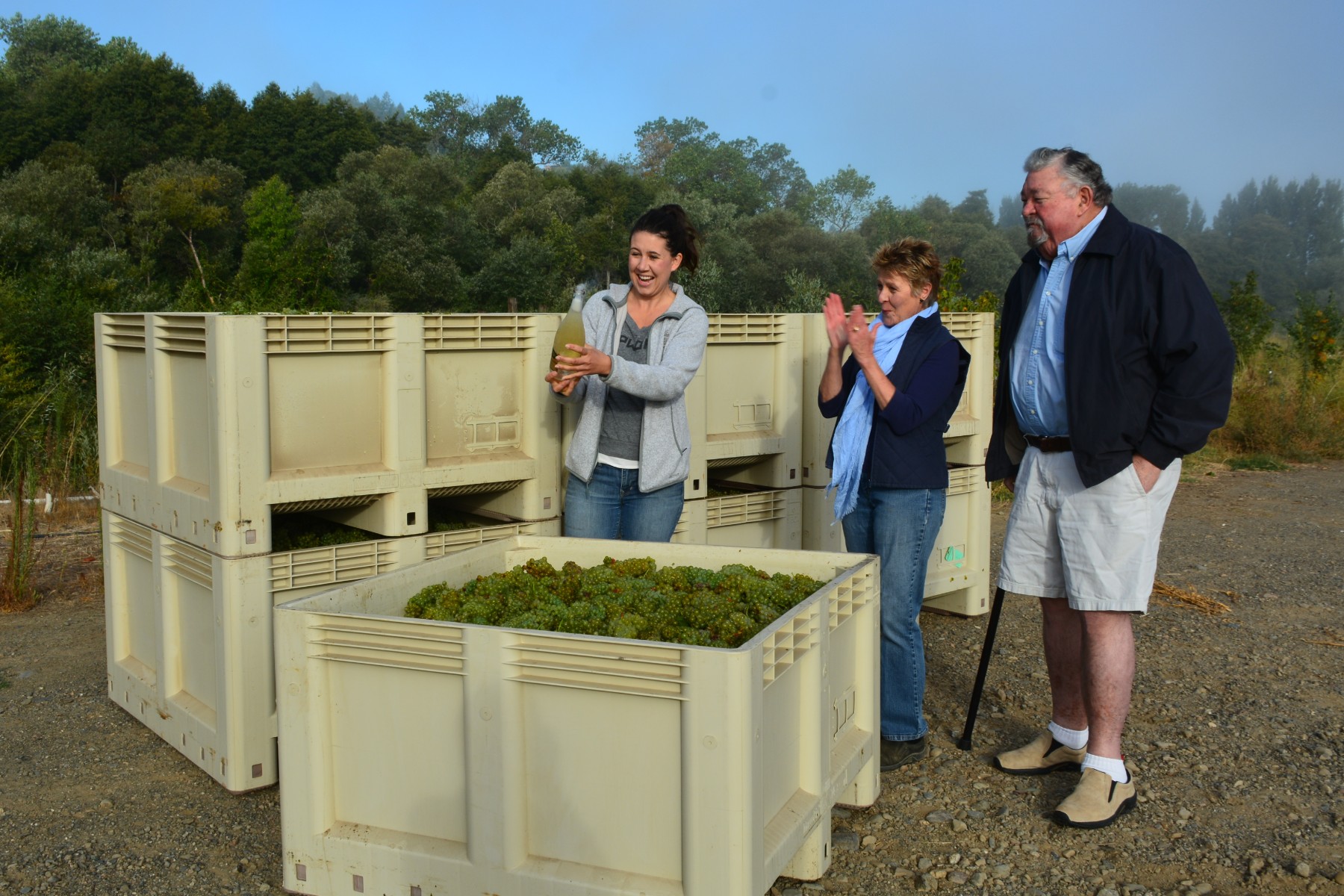
...and the 1st grower sparkling house in Healdsburg

Is Amista a Grower Sparkling House?
Yes! We grow our own grapes from a single estate and craft them into Amista Vineyards sparkling wines. In the picture above, my husband Mike Farrow, winemaker Ashley Herzberg and I bless the grapes during the first harvest of the season.
Not only is Amista a grower sparkling house, but we were also the 1st in Healdsburg. We made our first sparkling wine from our estate-grown Syrah in 2008. But what does it mean to be a grower sparkling house and why should you care? Let’s start with some background from Champagne, the quintessential region for making sparkling wine.
What is Grower Champagne?
Grower Champagnes are grown and produced by the same entity. The makers have their eyes (and hands) on their own vines year-round, meaning that they are the ones controlling how the land is being cultivated and when the grapes are picked. And they make and bottle the wine according to their winemaking style and philosophy rather than selling the grapes and letting someone else make the finished product. Grower Champagne houses are usually small, and family owned.
That may not be such an unusual idea in the U.S. since most wineries are small, family owned and produce wines from their own vineyards (even though the largest volume is produced by a few large companies). However, that is not the norm in Champagne.
How is Grower Champagne Different from the Large Champagne Houses?
Traditionally, Champagne is produced by large houses – “maisons” in French. They purchase grapes from thousands - yes, thousands - of growers in the Champagne region of France. These production houses are multi-national corporations that make hundreds of thousands of cases. They are essentially Champagne factories. They are well known because they also have big advertising budgets. You’ll recognize the big names like Moet & Chandon, Veuve Clicquot, and Perrier-Jouet.
Another difference is that the large houses blend their wines from that vast number of vineyards across multiple vintages. The climate in northern France is variable and challenging and not every year is perfect for growing grapes. Blending across vineyards and vintages produces a more consistent flavor profile and style. When you are making large volumes sold around the world, people want the product to taste the same year after year.
Why Grower Champagne Has Become Sought After
Grower Champagne has become more popular in the last two decades as growers in Champagne decided to make their own wine in addition to selling to the large houses. Grower Champagnes are treasured because they are limited and hard to find. People love to discover hidden gems!
Grower Champagnes are rarely known outside of France because they are made in extremely tiny quantities. Unlike the large production houses, they typically don’t make enough to export. So, you have likely never heard of them unless you travel to France.
The other reason they are coveted is because they have become known for producing exceptional quality Champagne. When it comes to Grower Champagne, these farmers are working with the same parcels every year, carefully managing how the vines are farmed and choosing the right time to harvest to bring out the best flavors in the wine.
Sparkling Wine Comes to California
The early sparkling houses in California were introduced by iconic French Champagne houses like Louis Roederer and Moet & Chandon, which began investing in California in the 1960s and 1970s.
In California, it is more common for a winery to grow and produce wines from its own grapes. Sure, there are very large wine production corporations that source grapes from hundreds of growers and make the equivalent of hundreds of thousands of cases of wine, sold in bottles, boxes, and cans.
But over 80% of the wineries in California are under 5,000 cases. It is common for the smaller wineries to grow and produce their own grapes. The idea of “grower wines” is more traditional in California that has been the case in Champagne.
But that wasn’t the case for the new sparkling wine producers in California. The early sparkling houses followed the model of Champagne – large production houses that purchased fruit from many growers rather than growing their own.
Grower Sparkling Houses Emerge in Sonoma
As happened in Champagne the Sonoma sparkling wine scene is also transforming. The pioneers of sparkling that came in the first wave, are large producers owned by a parent corporation in Champagne and most continue to source grapes from other growers.
In the second wave, family-owned wineries emerged that craft sparkling wines from their own vineyards. These also tend to be large producers since making sparkling wine is more complicated and requires a greater capital investment in production equipment than needed for making still wines. Producing in volume enables the winery to take advantage of economies of scale.
Only recently, in the last 15 years has Sonoma seen the emergence of a handful of small, sparkling wine houses making wines from their own estate vineyards – “grower sparkling houses”. This was enabled in part due to the opening of a local custom crush facility with the equipment to make sparkling wines. Small, family wineries suddenly had a facility where they could make sparkling wines from their estate vineyards crafted by their own winemaker.
Why Should I Care about Grower Sparkling Wine?
For those of you like me who are true lovers of bubbles, there a several reasons to care. One is the pure joy of finding beautiful sparkling gems made in very small batches and knowing that the same winery and winemaker nurtured that wine all the way from the grape to the glass.
If you appreciate experiencing the little variations from vintage to vintage based on the idiosyncrasy of the vineyard and the weather the year the grapes were grown, then you will enjoy exploring grower sparkling wines. It is more of an adventure than sipping the brand-consistent character of big sparkling houses – not that they aren't delicious, just less varied and interesting.
Another reason to care is because the wine is hand crafted by small wineries rather than produced in large volumes by a big corporate producer. It is a way to support the small family growers who have an intimate connection with the land, understand its peculiarities and can control the farming practices to ensure optimum quality.
You get a sense of their stewardship of the land and their love of turning their grapes into a finished product for others to enjoy. It's the same reason I go to the farmer’s market and choose a variety of freshly picked ripe tomatoes and talk directly with the farmer who grew them.
Come taste with us and explore a grower sparkling house for yourself!
What's the Best Season in Wine Country?
Every season is splendid when you're surrounded by vineyards!
How about a Spring rainbow watching over the mustard?

Or do you prefer Summer roses blooming next to the vines?

Maybe a spectacular harvest sunset?

